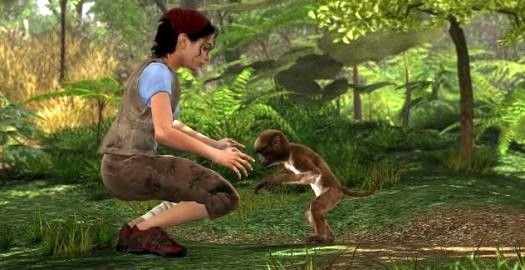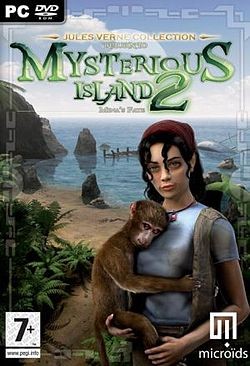Return to Mysterious Island 2 archived preview

In 2004, Kheops Studio released the unusual Return to Mysterious Island, a survivalist adventure set on the tropical isle inhabited by Captain Nemo in Jules Verne’s classic. With gameplay that emphasized inventory combinations and real-world logic, RTMI was the first of several Kheops releases to establish the studio’s unique knack for putting a new spin on classical literature (Voyage; Destination: Treasure Island) and history (Secrets of Da Vinci; Nostradamus). Five years later, the studio is revisiting Mysterious Island with a sequel, which I recently had the opportunity to see during a meeting with Benoit Hozjan, Kheops’ CEO.
As Return to Mysterious Island 2 opens, an introductory slideshow recaps what happened in the last game to provide context for those who didn’t play it. As is common in Kheops’ titles, this recap is depicted using comic book panels, but this time the comics are in full color, rather than their traditional black and white. The original game followed the adventures of Mina, a young girl who was trapped on the island a century after Verne’s novel took place. The intro shows Mina’s rescue from the island along with Jep, her simian companion. Their joy is short-lived, however, when the pilot loses control of the helicopter and it crashes into the sea, returning our protagonist to—you guessed it—Mysterious Island for round two.
RTMI2's gameplay begins with the pilot dead, Mina unconscious, and Jep, the monkey, the only able-bodied character in the wreck. This is where the sequel’s first standout feature emerges. In this game, rather than solely controlling Mina with Jep as a non-playable sidekick, you have the opportunity to play as both characters at various points. The game is still in first-person perspective, but playing part of the time as Jep means you get to see more of Mina, a treat previously reserved for the comic cutscenes. At some points you can switch between the playable characters at will. Other times, the game will force you to play as one or the other, such as in the opening scene, when Jep must save Mina from the sunken helicopter.
When you’re playing as Jep, the interface changes to accommodate this non-speaking character. You see his thoughts instead of hearing his interior monologue. Rather than communicating via dialogue trees, you are presented with an interface that allows you to take certain monkey-like actions. These interactions are limited—Jep doesn’t have the same range of reasoning and abilities as Mina—but you also have a unique perspective on the world around you that makes Jep better suited for solving certain puzzles. He’s lower to the ground and sometimes notices different elements in the environment than Mina. He is able to use items differently and fashion unique tools. And he can communicate with other monkeys and use the social relationships that develop to further his goals. For example, by offering food or gifts to the monkeys he meets early on, Jep can win their friendship. At a later point in the game, he’ll need a certain number of friends before he’ll be able to progress, turning the social hierarchy into a puzzle for the player to solve.
One of the core gameplay mechanics is somewhat reminiscent of the stats systems common in RPGs. Both Jep and Mina have energy levels that can be influenced with food, medical attention if they are wounded, and recreation. Limited amounts of food in areas of the island mean the player must be strategic about keeping the characters satiated. The complex inventory system from the previous game has returned, with the player selecting from a large bank of stored items and combining these to complete an on-screen formula to build tools and solve puzzles. The items Mina carries are more diverse and the formulas more complex than Jep’s, but only Jep can fashion certain tools and communicate with the monkeys, meaning the two must work as a team to achieve their goals.
Some locations return from the previous game, but with added detail and subtle modifications suggesting changes on the island. Such changes become especially apparent as a mysterious green gas seeps across the island and takes a toll on the plant life and environment. The island is progressively changing, and it’s your job to find out why. The mysterious gas sets up an uneasy tension as Mina and Jep explore previously untouched areas, looking for answers.
While RTMI2’s gameplay seems fairly similar to its predecessor’s, the sequel has a couple of features that open up new possibilities for gamers. One addition is a chat interface inside the game that will allow players on different computers to communicate and solve puzzles in tandem. The game also has an iPhone counterpart that will make some puzzles available on the iPhone, away from your computer. You can then sync up your iPhone progress with the game on your PC, and when you encounter these already-solved puzzles in the PC version, you’ll have the option to skip them. Although Benoit described both of these features to me, I wasn’t able to see them in action, so it’s hard to say how much of an impact they’ll have on the playing experience.
From what I saw, Return to Mysterious Island 2 appears to be a faithful evolution of the first game. Benoit told me this is a bigger game than the original, with several new environments (parts of the island that were not seen in the first game, as well as new underground locations) and two different endings. The mechanics, though, are firmly planted in the Kheops tradition, making Return to Mysterious Island 2 a sequel worthy of checking out if you’re a fan of the studio’s work. The game will be published worldwide by Microïds, and is currently scheduled for a June release.













